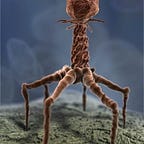The Real Anatomy Park
The Adult Swim television show Rick and Morty has become a personal and cult favorite. Always hilarious, often dark and contemplative, the show follows the adventures of a mad, alcoholic scientist and his young grandson.
In Season 1, Episode 3, we learn that Rick has been using the body of a homeless man to host the world’s smallest amusement park. He has been shrinking workers down to microscopic levels so they can create “Anatomy Park,” a tourist destination that transforms human bodily functions into Disney attractions. The park is also a testament to human disease — it features mankind’s deadliest pathogens, similar to Jurassic Park.
As Morty soon discovers, Anatomy Park is no more functional than its dinosaur counterpart. The diseases have escaped and are running amok inside our homeless friend. The animators obviously do not make the diseases look remotely realistic, but the show’s flippant attitude towards scientific accuracy is what makes it work so well. However, I thought it would be fun to compare the animated diseases featured in the episode to the images of them in real life.
So, welcome to the Real Anatomy Park. Please keep your hands and feet inside the vehicle at all times, and refrain from touching the exhibits.
Hepatitis A looks much less intimidating here than it does in the episode. It is a positive-sense, single-stranded RNA virus of the Picornaviridae family. It locates to the liver, where it multiplies within hepatocytes and liver macrophages. The time between infection and the onset of symptoms can be 2–6 weeks. It is most commonly spread in water contaminated with feces.There are about 1.5 million symptomatic cases every year, and ~100,000 deaths. The vaccine is effective for prevention.
Tuberculosis (TB) is caused by various strains of mycobacteria, usually Mycobacterium tuberculosis, pictured above. It has an unusual, waxy coating on its surface that makes it impervious to Gram staining. It generally infects the lungs, and is spread through the air. One-third of the world’s population is thought to be infected with this bacteria, but most infections remain latent. There are about 15 million chronic cases active globally, and an estimated 1.5 million deaths in 2013. If left untreated, TB will kill over 50% of those it actively infects. Treatment requires the administration of multiple antibiotics over a long period of time.
The animators did a really good job imitating gonorrhea here. Gonorrhea is caused by a species of Gram-negative coffee bean-shaped diplococci bacteria, Neisseria gonorrhoeae. The long, spindly arms are Type IV pili; they act as grappling hooks to drag the cell forward.
Gonorrhea is a sexually transmitted infection. There are about 88 million cases worldwide, and in 2010 it caused 900 deaths. Ceftriaxone is one of the few effective antibiotics against N. gonorrhoeae. In individuals with gonorrhea, chlamydia infection is also common.
Bubonic plague is one of the three types of bacterial infection caused by Yersinia pestis, a Gram-negative, rod-shaped coccobacillus and facultative anaerobe. This bacteria is believed to be responsible for the Black Death in Europe. It is spread from the fleas on small animals or from the bodily fluids of a dead infected animal. The bacteria migrate to the lymph nodes, causing them to swell and sometimes burst. The Rick and Morty animators colored the bacterium black in honor of the dark swollen lymph nodes, or buboes. Bubonic plague is extremely deadly, killing up to 90% of those who go untreated and 10% of those who do have treatment. In 2013, there were 750 documented cases and 126 deaths.
In the episode, the E. coli portrayed as a complex virus like bacteriophage T4. Escherichia coli is in fact a bacteria, and it is one of the most familiar to us. It is the classic model of a Gram-negative, facultatively anaerobic, rod-shaped bacterium. It is an essential organism for our survival, peacefully residing in our intestines, producing Vitamin K and preventing pathogenic bacteria from colonizing. Most strains do not cause disease, but pathogenic strains can cause gastroenteritis, urinary tract infections, and neonatal meningitis. E. coli is found in animal waste, so its presence can indicate unsanitary conditions.
Hepatitis C saves Morty and Annie by eating Hepatitis A. This would most likely not happen, since Hep C is also a positive-sense, single-stranded RNA virus of similar size. You can see how the show incorporated elements of the viral envelope onto the back of the Hepatitis C monster. Hepatitis C is spread from blood-to-blood contact, and infects the liver. In chronic infections, in can lead to liver damage, cirrhosis, and liver cancer.
I hope you enjoyed this tour of some of humanity’s most infamous diseases. Please stop by our gift shop on the way out if you’d like to pick up a really bad cough.
“Sometimes science is more art than science.” — Rick
For more posts about disease and biology, subscribe to Cell Your Soul. Feel free to comment below or message your feedback!
